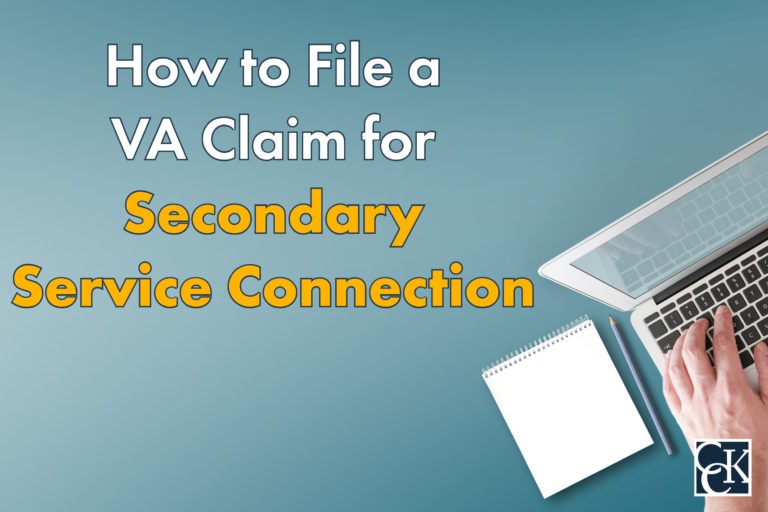How to File a VA Claim for Secondary Service Connection

CCK Law: Our Vital Role in Veterans Law
There are several types of service connection, including direct service connection, presumptive service connection, and, of course, secondary service connection.
Before VA grants disability benefits, veterans must establish service connection. Service connection is the acknowledgment that your current disabling condition was either caused or aggravated by your time in service.

What is a Secondary Service-Connected Condition?
If a veteran’s service-connected condition causes or leads to a separate illness or disability, this is called a secondary service-connected condition.
For example, say a veteran is service-connected for a knee condition and later develops arthritis in that knee. Here, the veteran’s arthritis may warrant secondary service connection if it was caused by the service-connected knee condition.
Secondary service connection can also apply to mental health conditions. If a veteran suffers from a debilitating physical condition, they may develop depression due to the chronic pain and limitations on daily activities.
Common Secondary Service-Connected Conditions
As mentioned above, secondary service-connected conditions are conditions caused or aggravated by an already service-connected disability. Some of the most common secondary service-connected conditions include the following:

Peripheral Neuropathy Secondary to Diabetes Mellitus Type 2
Service-connected diabetes mellitus type 2 can lead to multiple other medical conditions. One of the most common is peripheral neuropathy, which impacts a veteran’s peripheral nerves and can cause numbness, weakness, and tingling in the upper and lower extremities (e.g., feet and hands).
Radiculopathy Secondary to a Back Disability
Radiculopathy is a nerve condition that occurs when a veteran’s spinal nerve is pinched, resulting in weakness, tingling, or numbness in their legs or arms.
Radiculopathy can occur in the cervical spine (neck), thoracic spine, or lumbar spine, depending on the location of the back condition. Radiculopathy commonly stems from back conditions such as a herniated disc or spinal stenosis.
Hypertension Secondary to PTSD
Veterans with post-traumatic stress disorder (PTSD) may develop hypertension secondary to their PTSD, due to the increased stress and anxiety they experience.
How to File a VA Secondary Claim
Filing a secondary VA claim for service connection involves the same process as filing any other initial claim.
Veterans should fill out and submit VA Form 21-526EZ – VA’s application for disability compensation and related compensation benefits. Veterans may do so online, in person at their local Regional Office, or with help from an accredited veterans’ advocate or attorney.
Importantly, to prove secondary service connection, there is certain evidence that a veteran should submit alongside their claim. Veterans will need to demonstrate two things to VA to be granted service connection for a secondary condition:
- A current diagnosis of the secondary injury, illness, or disability; and
- Medical evidence showing a link between your service-connected condition and secondary condition.
Types of Evidence to Submit with Secondary VA Claims
In VA secondary claims, providing a nexus (i.e., link) is essential. In cases of secondary service connection, a nexus is a medical opinion that links a veteran’s secondary disability to their already service-connected disability.
You must clearly establish a link between your primary service-connected condition and your secondary condition to be granted additional disability benefits. VA health care providers or private physicians can offer critical medical evidence to substantiate secondary VA claims. Any relevant medical records should be submitted to VA.
Lay evidence may also be helpful in proving secondary service connection. Veterans can submit lay statements outlining how their already service-connected condition(s) caused or aggravated their secondary condition.
How Does VA Rate Secondary Disabilities?
Once secondary service connection is established, VA will assign a disability rating to your secondary condition. VA rates secondary disabilities the same way it rates conditions service-connected on a direct basis—using VA’s Schedule for Rating Disabilities.
Each condition is rated using a diagnostic code in the rating schedule. Based on the medical evidence you provided, VA will look at the severity of your symptoms and determine the percentage in the diagnostic code with which they most closely relate to decide your disability rating.
If you have multiple service-connected conditions, the ratings will be added together using VA math. The resulting combined disability rating will determine your monthly benefit amount.
How CCK Can Help You Prove Secondary Service Connection
If VA denied your claim for secondary service connection, Chisholm Chisholm & Kilpatrick LTD may be able to help you file an appeal. The accredited veterans’ advocates and attorneys at CCK have the knowledge and experience needed to help veterans prove secondary service connection and secure VA benefits.
Reach out to CCK today to schedule a free consultation at 800-544-9144.
About the Author
Share this Post


